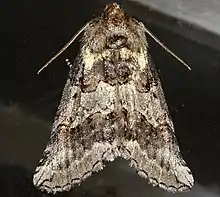Ceranemota improvisa
Ceranemota improvisa is a moth in the family Drepanidae. It was described by Henry Edwards in 1873.[1] It is found in North America, where it has been recorded from northern California, western Oregon, western Washington and south-western British Columbia.[2] The habitat consists of mixed hardwood forests, coastal rainforests and mixed hardwood-conifer forests.
| Ceranemota improvisa | |
|---|---|
 | |
| Scientific classification | |
| Kingdom: | |
| Phylum: | |
| Class: | |
| Order: | |
| Family: | |
| Genus: | |
| Species: | C. improvisa |
| Binomial name | |
| Ceranemota improvisa (H. Edwards, 1873) | |
| Synonyms | |
| |
The length of the forewings is about 16 mm. The forewings are banded greenish grey and dark brown grey. The hindwings are medium brown grey with a faint grey discal spot and terminal line. Adults are on wing from late September to November in one generation per year.
The larvae feed on Crataegus douglasii and Prunus species.[3]
References
- Beccaloni, G.; Scoble, M.; Kitching, I.; Simonsen, T.; Robinson, G.; Pitkin, B.; Hine, A.; Lyal, C., eds. (2003). "Ceranemota improvisa". The Global Lepidoptera Names Index. Natural History Museum. Retrieved April 19, 2018.
- "850010.00 – 6242 – Ceranemota improvisa – (Edwards, 1873)". Moth Photographers Group. Mississippi State University.
- Pacific Northwest Moths
This article is issued from Wikipedia. The text is licensed under Creative Commons - Attribution - Sharealike. Additional terms may apply for the media files.